Before the War
Racism & Segregation
-
 The NAACP flew this flag at its New York headquarters to report lynchings until the building owner threatened to evict the organization in 1938. Library of Congress, LC-DIG-ppmsca-09705
The NAACP flew this flag at its New York headquarters to report lynchings until the building owner threatened to evict the organization in 1938. Library of Congress, LC-DIG-ppmsca-09705At the end of World War I, black soldiers returned home to find that the country they served still saw them as second-class citizens. In the South, Jim Crow "separate but equal" laws relegated African Americans to “black only” drinking fountains, bus seats, and schools. Jobs were harder to find for African Americans than for whites, and paid less. Discrimination was a daily part of American life. For black Americans, so too was the threat of violence: Operating largely in shadows, the Ku Klux Klan was at the height of its power during the 1920s.
-
 Jim Crow, a racist stereotype personified by white actor Thomas D. Rice in the 1830s, was meant to emphasize the inferiority of African Americans. Library of Congress, LC-DIG-ds-00886.
Jim Crow, a racist stereotype personified by white actor Thomas D. Rice in the 1830s, was meant to emphasize the inferiority of African Americans. Library of Congress, LC-DIG-ds-00886. The Ku Klux Klan marches in Washington, D.C. at the height of its resurgence in the 1920s. Library of Congress, LC-DIG-npcc-16219.
The Ku Klux Klan marches in Washington, D.C. at the height of its resurgence in the 1920s. Library of Congress, LC-DIG-npcc-16219.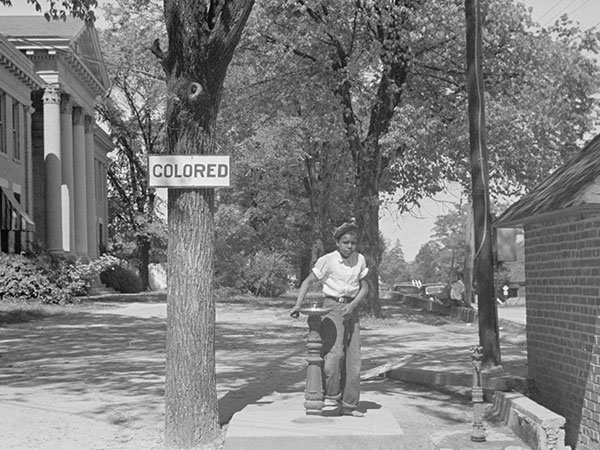 Segregated drinking fountains, such as this one in Halifax, North Carolina, were a part of life in the Deep South. Library of Congress, LC-DIG-fsa-8a03228.
Segregated drinking fountains, such as this one in Halifax, North Carolina, were a part of life in the Deep South. Library of Congress, LC-DIG-fsa-8a03228. Signs such as these were a part of life in the American South for decades. Many African American men and women from the northern or western United States first experienced segregation after joining the military during World War II and being sent south for training. The National WWII Museum, 2015.079
Signs such as these were a part of life in the American South for decades. Many African American men and women from the northern or western United States first experienced segregation after joining the military during World War II and being sent south for training. The National WWII Museum, 2015.079 -
Activists including W.E.B. Du Bois, A. Philip Randolph, and many others spoke out in protest of discriminatory practices, helping workers organize into unions to lobby for fair wages, publicizing the struggle of African Americans, and arguing for change in the books and newspapers that made up the "Black Press."
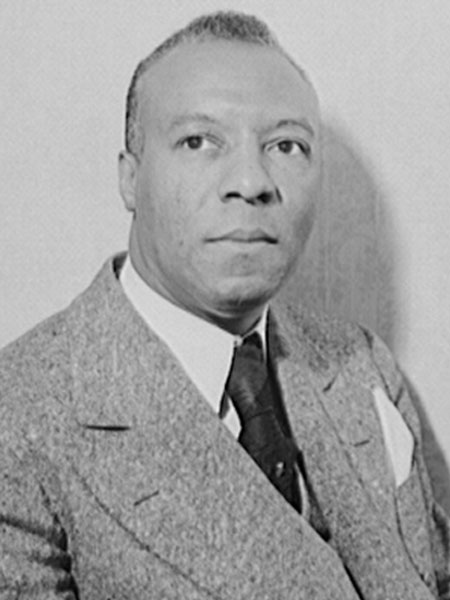 A. Philip Randolph was one of the great leaders of the Civil Rights Movement in the 1940s. Library of Congress, LC-USW3-011696-C.
A. Philip Randolph was one of the great leaders of the Civil Rights Movement in the 1940s. Library of Congress, LC-USW3-011696-C. A. Philip Randolph was one of the great leaders of the Civil Rights Movement in the 1940s. Library of Congress, LC-USW3-011696-C.
A. Philip Randolph was one of the great leaders of the Civil Rights Movement in the 1940s. Library of Congress, LC-USW3-011696-C.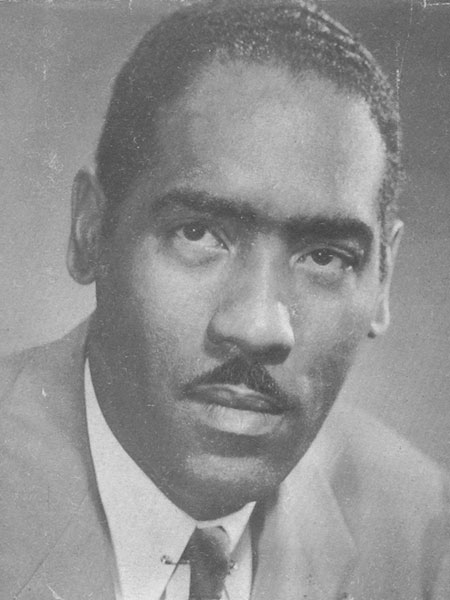 Second Lieutenant Vincent “Roi” Ottley was among the most widely read black correspondents of the war. The Roi Ottley Collection, St. Bonaventure University Archives.
Second Lieutenant Vincent “Roi” Ottley was among the most widely read black correspondents of the war. The Roi Ottley Collection, St. Bonaventure University Archives. Second Lieutenant Vincent “Roi” Ottley was among the most widely read black correspondents of the war. The Roi Ottley Collection, St. Bonaventure University Archives.
Second Lieutenant Vincent “Roi” Ottley was among the most widely read black correspondents of the war. The Roi Ottley Collection, St. Bonaventure University Archives. War correspondent Ted Stanford of The Pittsburgh Courier interviews First Sergeant Morris O. Harris of the 784th Tank Battalion. National Archives, 208-AA-32P-14.
War correspondent Ted Stanford of The Pittsburgh Courier interviews First Sergeant Morris O. Harris of the 784th Tank Battalion. National Archives, 208-AA-32P-14. War correspondent Ted Stanford of The Pittsburgh Courier interviews First Sergeant Morris O. Harris of the 784th Tank Battalion. National Archives, 208-AA-32P-14.
War correspondent Ted Stanford of The Pittsburgh Courier interviews First Sergeant Morris O. Harris of the 784th Tank Battalion. National Archives, 208-AA-32P-14.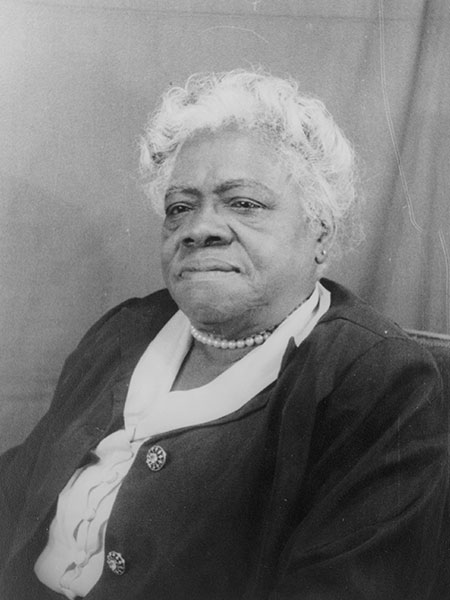 Mary McLeod Bethune, founder of Roosevelt’s Black Cabinet, was a lifelong champion of equal rights for African Americans. Library of Congress, Prints & Photographs Division, Carl Van Vechten Collection, LC-USZ62-128514.
Mary McLeod Bethune, founder of Roosevelt’s Black Cabinet, was a lifelong champion of equal rights for African Americans. Library of Congress, Prints & Photographs Division, Carl Van Vechten Collection, LC-USZ62-128514. Mary McLeod Bethune, founder of Roosevelt’s Black Cabinet, was a lifelong champion of equal rights for African Americans. Library of Congress, Prints & Photographs Division, Carl Van Vechten Collection, LC-USZ62-128514.
Mary McLeod Bethune, founder of Roosevelt’s Black Cabinet, was a lifelong champion of equal rights for African Americans. Library of Congress, Prints & Photographs Division, Carl Van Vechten Collection, LC-USZ62-128514. -
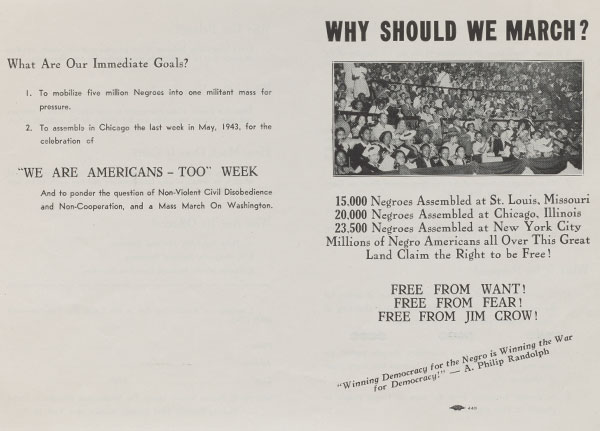 A. Philip Randolph cancelled a 50,000-man march on Washington, DC, in 1941 after President Franklin Delano Roosevelt signed an executive order banning racial discrimination in war industries. But Randolph’s “March on Washington Movement” continued to press for additional civil rights reforms during the war. Courtesy of the A. Philip Randolph Institute, Washington, DC.
A. Philip Randolph cancelled a 50,000-man march on Washington, DC, in 1941 after President Franklin Delano Roosevelt signed an executive order banning racial discrimination in war industries. But Randolph’s “March on Washington Movement” continued to press for additional civil rights reforms during the war. Courtesy of the A. Philip Randolph Institute, Washington, DC. Three women hold a sign reading “Segregation is Discrimination” at a demonstration in Houston, Texas, part of a rising tide of protests during the WWII era. Library of Congress, LC-USZ62-118872.
Three women hold a sign reading “Segregation is Discrimination” at a demonstration in Houston, Texas, part of a rising tide of protests during the WWII era. Library of Congress, LC-USZ62-118872.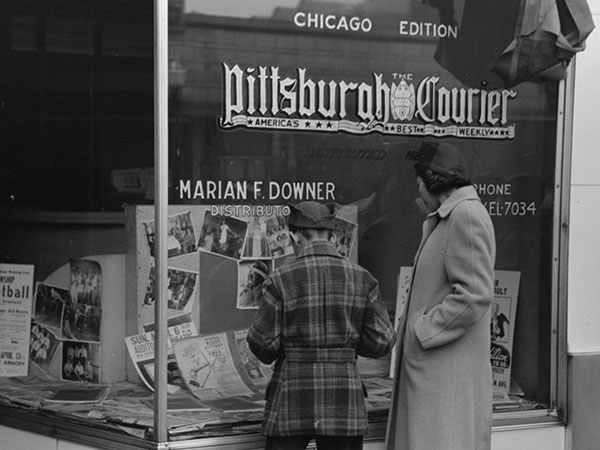 This Chicago storefront was the local office of The Pittsburgh Courier, one of the most widely read African American newspapers during the war. Library of Congress, LC-DIG-fsa-8a29874.
This Chicago storefront was the local office of The Pittsburgh Courier, one of the most widely read African American newspapers during the war. Library of Congress, LC-DIG-fsa-8a29874.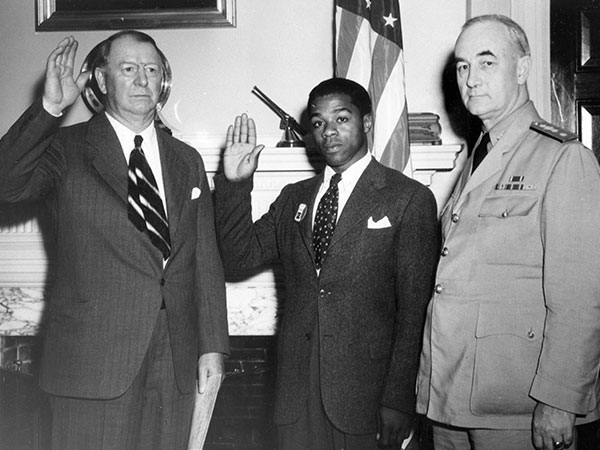 In June 1942, the US Navy began accepting black men for service outside of the steward branch. William Baldwin (center) was the first General Service recruit. National Archives, 208-NP-8B-2.
In June 1942, the US Navy began accepting black men for service outside of the steward branch. William Baldwin (center) was the first General Service recruit. National Archives, 208-NP-8B-2.




